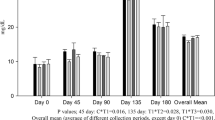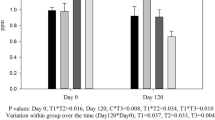Abstract
Twenty male buffalo calves (8–9 months, 112.1 ± 7.69 kg) were divided into four groups of five animals in each and fed diets without (T1) or supplemented with 0.3 ppm selenium (Se) (T2), 0.3 ppm Se + 10 ppm copper (Cu) (T3), and 10 ppm Cu (T4) for 120 days during which blood samples were collected on day 0, 40, 80, and 120. Concentrations of glucose, total protein, urea, uric acid, and creatinine were similar in all the four groups, but the level of globulin was significantly (P < 0.01) increased in groups T2 and T3, leading to reduced levels of albumin and A:G ratio (P < 0.01) in these groups. The level of different serum enzymes viz. lactate dehydrogenase (LDH), alkaline phosphatase (ALP), glutamate pyruvate transaminase (SGPT), and glutamate oxaloacetate transaminase (SGOT) and hormones viz. T3, T4, testosterone and insulin and T4:T3 ratio were similar (P > 0.05) among the four groups. It was deduced that supplementation of 0.3 ppm Se and/or 10.0 ppm of Cu had no effect on blood metabolic profile in buffalo calves, except for an increased globulin level, indicating improved immunity status of these animals.
Similar content being viewed by others
References
Patterson EL, Milstrey R, Stokstad ELR (1957) Effect of selenium in preventing exudative diathesis in chicks. Proc Soc Exp Biol Med 95:617–620
Davis KG, Mertz W (1987) Copper. In: Mertz W (ed) Trace elements in human and animal nutrition, 5th edn. Academic, New York, pp 301–364
Stapleton SR (2000) Selenium: an insulin-mimetic. Cell Mol Life Sci 57:1874–1879
Chan S, Gerson B, Subramaniam S (1998) The role of copper, molybdenum, selenium, and zinc in nutrition and health. Clin Lab Med 18:673–685
Uauy R, Olivares M, Gonzalez M (1998) Essentiality of copper in humans. Am J Clin Nutr 67:952S–959S
N.R.C. (2001) Nutrient requirements of dairy cattle, 7th ed. National Academy, Washington, DC
Pimentel JL, Cook ME (1987) Suppressed humoral immunity in chicks fed diets deficient in sodium, chloride or both sodium and chloride. Poultry Sci 66:2005
Pathak NN, Verma DN (1993) Nutrient requirement of Buffalo, 1st edition. International Book Distributing Co., Lucknow, (U.P.) India
Henry RJ (1963) Standard methods of clinical chemistry, 1st edn. Harper and Row Publishing Company, New York, USA
Dumas BT, Watson WA, Briggs HG (1971) Albumin standards and the measurement of serum albumin with bromocresol green. Clin Chem Acta 31:87–96
Wybenga DR, Digiorgio J, Pileggi VJ (1971) Manual and automated methods for urea nitrogen measurement in whole serum. Clin Chem 17:891
Bonses RW, Tausskay HH (1945) The colorimetric determination of creatinine by the Jaffe reaction. J Biol Chem 158:581
Caraway WT (1963) Standard methods of clinical chemistry. In: Seligson D (ed). Academic, New York, London, 4, 239
Kind PRM, King EJ (1954) Estimation of serum alkaline phosphatase activity by colorimetric method. J Clin Pathol 7:322
Reitman S, Frankel SE (1957) A colorimetric method for the determination of serum glutamic oxaloacetic transaminase and serum glutamic pyruvic transaminase. Am J Clin Pathol 28:56–63
Wroblewski VF, Duean LS (1955) Bestimmung der Aktivital der lactat-dehydrogenase. Proc Soc Exp Biol 90:210–214
Snedecor GW, Cochran WG (1989) Statistical methods, 8th ed. Iowa State University Press, Ames, Iowa
Steel RGD, Torrie JH (1980) Principles and procedures of statistics. A biometrical approach, 2nd ed. McGraw-Hill International Book Company, New Delhi, India
Singh R, Randhawa SS, Dhillon KS (2002) Changes in blood biochemical and enzyme profile in experimental chronic selenosis in buffalo calves (Bubalus bubalis). Indian J Anim Sci 72:230–232
Mondal MK, Roy B, Biswas P (2004) Effect of supplementation of Cu on nutrient utilization by black Bengal kids. Indian J Anim Nutr 21:261–264
Arthur JR, Morrice PC, Beckett GJ (1988) Thyroid hormone concentrations in selenium deficient and selenium sufficient cattle. Res Vet Sci 45:122–123
Khan SA (1978) Interaction of copper and zinc and its influence on the metabolism of major nutrients in growing calves, Ph.D. Thesis, Aligarh Muslim University, Aligarh. India
Shashidhar G, Prasad T (1993) Influence of selenite and selenomethionin administration on serum transaminases and hematology of goats. Indian J Anim Nutr 10:1–6
Fehrs MS, Miller WJ, Gentry RP, Neathery MW, Blackmon DM, Heinmiller SR (1981) Effect of high but non-toxic dietary intake of copper and selenium on metabolism in calves. J Dairy Sci 64:1700–1706
Du Z, Hemken RW, Harmon RJ (1996) Copper metabolism of Holstein and Jersey cows and heifers fed diets high in cupric sulphate or copper propionate. J Dairy Sci 79:1873–1880
Jenkins KJ, Hidiroglou M (1989) Tolerance of the calf for excess copper in milk replacer. J Dairy Sci 72:150–156
Lee SH, Engle TE, Hossner KL (2002) Effects of dietary copper on the expression of lipogenic genes and metabolic hormones in steers. J Anim Sci 80:1999–2005
Wichtel JJ, Craigie AL, Freeman DA, Varela-Alvarez H, Williamson NB (1996) Effect of selenium and iodine supplementation on growth rate and on thyroid and somatotropic function in dairy calves at pasture. J Dairy Sci 79:1865–1872
Chadio SE, Kotsampasi BM, Menegatos JG, Zervas GP, Kalogiannis DG (2006) Effect of selenium supplementation on thyroid hormone levels and selenoenzyme activities in growing lambs. Biol Trace Elem Res 109:145–154
Terasawa E, Fernandez DL (2001) Neurobiological mechanisms of the onset of puberty in primates. Endocr Rev 22:111–151
Acknowledgment
First author is thankful to Indian Council of Agricultural Research, Krishi Bhawan, New Delhi, for providing financial assistance in the form of Senior Research Fellowship.
Author information
Authors and Affiliations
Corresponding author
Rights and permissions
About this article
Cite this article
Mudgal, V., Garg, A.K., Dass, R.S. et al. Effect of Selenium and Copper Supplementation on Blood Metabolic Profile in Male Buffalo (Bubalus bubalis) Calves. Biol Trace Elem Res 121, 31–38 (2008). https://doi.org/10.1007/s12011-007-8002-x
Received:
Revised:
Accepted:
Published:
Issue Date:
DOI: https://doi.org/10.1007/s12011-007-8002-x




